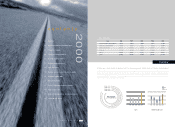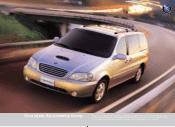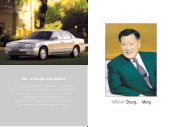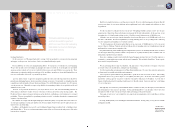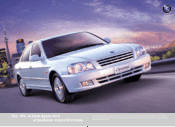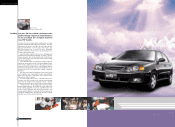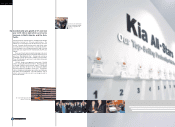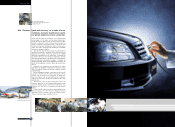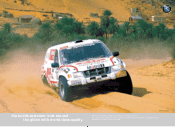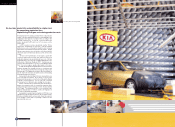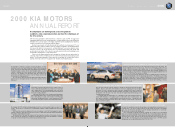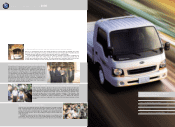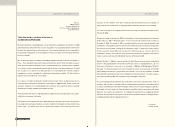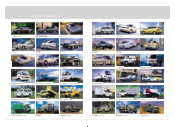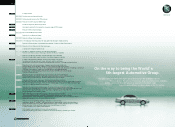Kia 2000 Annual Report Download - page 12
Download and view the complete annual report
Please find page 12 of the 2000 Kia annual report below. You can navigate through the pages in the report by either clicking on the pages listed below, or by using the keyword search tool below to find specific information within the annual report.
Kia employees are working hard across the globe to
establish a new corporate position and meet the challenges of
the 21st century.
2000 KIA MOTORS
AN N UAL REPO RT
1. Creation of the nations first automotive group
On September 1, 2000, ten companies, including Kia Motors, received
permission from the Fair Trade Commission to spin off from the Hyundai
Group. This decision allowed Kia Motors, Hyundai Motor, Hyundai Mobis,
Hyundai Capital, Inchon Steel and Hyundai Hysco to work
together to challenge the 5th spot among the worlds leading automobile
producers. The formation of this automotive group has created a new
automotive specialist with a unique corporate image and has laid
the foundation for stable operations.
As of the end of 1999, this automotive group had 90,000 employees
and the nations 5th largest amount of total assets, valued at 31.723
trillion won.
4. Introduction of the Spectra and Optima, No.2 ranking in passenger cars in Korea
Kia Motors unveiled the Spectra, a near-mid-sized passenger car in May 2000. The
mid-sized Optima was then unveiled in July. These two models rapidly put Kia in the No.2
ranking in domestic passenger vehicle market share. As soon as the Optima came out, it
generated a flurry of sales and steadily increased market share until finally grabbing the top
spot for mid-sized passenger vehicles. The Optima was later distinguished with the honor of
selection as a Hit Productby various local media.
This success in the domestic market has served as a springboard for boosting sales of
the value-added Optima in the US and European markets. The Optima is now being
cultivated as a main export model. In addition, Kia improved its product competitiveness last
year with the introduction of numerous models including the Letona Cruiser SUV, one-ton
Bongo Frontier truck and the 2.5/3.5-ton Pamax trucks and the Spectra Wing, a follow-up
model to the Shuma.
3. Surmounting legal obstacles to become an industry leader
On February 16, 2000, Kia Motors finally graduated from the court receivership it had been under for 15
months. The Kia case is considered to be a representative example of rapid normalization by an insolvent
company.
Last year, Kia recorded the highest profits since its founding. In late 1997, Kia managed to lower its
liability-to-equity ratio, which had hovered around to 810%, to within the government-established guidelines.
This set Kias transformation into action.
On February 23rd of last year, Kia celebrated its "New Departure, New Take-off Declaration Ceremony."
At the ceremony, Kia reaffirmed its commitment to quality and service innovation and pledged to contribute
to national economic development as a world-class automotive specialist.
6. Production line reorganization and remarkable productivity gains
Last year, Kia specialized production through large-scale reorganization and expansion of all
production lines. The one-ton Frontier production line was moved from Sohari to the Kwangju
plant. Also, the lines were specialized to suit the individual characteristics of each facility.
This move helps to maximize the synergy effect.
Kia is increasing new facility investments, including the construction of a new painting
plant, to boost annual Carnival production to 200,000 units. Hourly productivity has also been
greatly increased at each facility. Sohari Carnival line output has been raised from 18.7 UPH
(units per hour) to 30 UPH. Moreover, the Rio line has been improved to 29.3 UPH from a pre-
vious 24 UPH. The Hwasung 3rd plant productivity went from 33.3 to 40 UPH, and the
Kwangju plant van line was vastly improved from 7.5 to 18.7 UPH.
2. Relocating the main office to Yangjae-dong
After being re-launched, Kia moved from its former location on
Yoido to work with Hyundai Motor in a brand new, 21-story build-
ing in Yangjae-dong. The new Headquarters now serves as the
center of Koreas auto industry and has attracted the attention of
the worlds leading carmakers.
With their joint relocation to the Yangjae-dong Headquarters,
Kia and Hyundai will be able to achieve a greater synergy effect.
Also, the building is located at the entrance of the Kyongbu
Expressway, the gateway to Seoul, so both companies are closer
to their respective plants, research centers and related facilities.
5. Full-scale deployment of the Six Sigma management innovation program
Last year, Kia conducted a special program to educate all employees about the Six Sigma
initiative. Black or green belts were awarded to 187 people, qualifying them as Six Sigma
specialists. A total of 168 projects were completed, saving 8.9 billion won in improved
efficiency. These results raised the international quality survey (IQS) score by 83 points over the
performance in the first half of last year. This was the largest improvement among all the
companies that were tested.
In February 2000, Kia established a set of standards for new model quality and worked to
acquire ISIR certification so the quality of parts for new models can be secured quickly. Kia
also carried out activities to cultivate quality in all production processes. Through these and
other continuous quality improvement efforts, Kia is striving to join the worlds top five auto
producers in terms of quality.
KiaM otors annual reports 2000
Highlights
After becoming profitable in 1999, Kia Motors continued to grow in 2000. An aggressive
management approach includes a marketing blitz to conquer markets both at home and abroad.
Meanwhile, the successive launch of the highly competitive Spectra and Optima has enabled us
to grab second place in the Korean passenger car market.
Kia has focused exports on North America and the Asia-Pacific, boosting exports 17% over
1999. Bolstered by renewed confidence from our operation normalization, we invited Kia dealers
from around the world to Korea as part of our New Millennium Tour, and accelerated service
activities overseas. On the production side, we worked hard at improving quality and
productivity at every facility. At the same time, we vastly bolstered efficiency through large-scale
reorganization and expansion of our production lines.
Kia put the Six Sigma quality innovation program into full gear last year and pushed for
systematic improvement in everything from new model development and manufacturing to parts
quality. The real-name maintenance system was also incorporated into our after-sales services,
and Kia service has come to be recognized for its Kindness, Speed and Accuracy.


